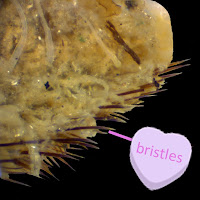 |
| This juvenile Aphrodita specimen has had some of its dorsal (top) covering removed, exposing the elytra beneath. |
Worm and fuzzy

The Sea Mouse may be brown and fuzzy, but that is about all it shares with its mammalian namesake. Believe it or not, the Sea Mouse is actually a marine segmented worm, or polychaete! This is more obvious if you flip it over on its back, exposing its segmented underside.
Sea Mice are members of the family Aphroditidae - one of several families of scale worms, characterized by elytra (scale-like plates running down their backs). However, the Sea Mouse’s elytra are completely hidden under a tangled mat of hair-like setae and mucus that cover the worm’s dorsal (top) surface.
Pulling the wool over your eyes
The Puget Sound species of Aphrodita are typically scavengers, using their palps to search around in the mud for delicious dead things to munch on. However, some species of Sea Mice found elsewhere in the world are predators, eating other polychaetes and small crabs.
Mouse trap
On the polychaete size scale, the Sea Mouse is actually pretty hefty, with some growing to about 15 cm (6 inches) long. They live in soft sediments, like mud or sand, generally in shallow depths (to about 120 meters in Puget Sound). Although we sample in these areas, we rarely see sea mice in our benthic grabs. However, when we do, we have to examine them closely under a microscope to make sure we identify them correctly. We look at the number of segments, the length of the antennae and the type of setae to distinguish the three species we see in Puget Sound: Aphrodita japonica, A. negligens, and A. parva.Of mice and men
 |
Head of an Aphrodita specimen, dorsal
(top) view. |
- Long, soft hairs that cover its back.
- Tough, hollow bristles made of chitin that stick out of its parapodia, or feet.
 |
| Close-up of bristles around the bottom of Aphrodita negligens. |
By: Dany Burgess & Angela Eagleston, Environmental Assessment Program
Critter of the Month
Our benthic taxonomists, Dany and Angela, are scientists who identify and count the benthic (sediment-dwelling) organisms in our samples as part of our Marine Sediment Monitoring Program. We are tracking the numbers and types of species we see in order to understand the health of Puget Sound and to detect any changes over time.Dany and Angela share their discoveries by bringing us a Benthic Critter of the Month. These posts will give you a peek into the life of Puget Sound’s least-known inhabitants. We’ll share details on identification, habitat, life history, and the role each critter plays in the sediment community. Can't get enough benthos? See photos from our Eyes Under Puget Sound collection on Flickr.


No comments:
Post a Comment
We will not post comments with links to commercial sites, so please do not include them! Thank you.
(Comments Policy)